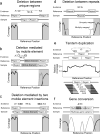Identification of mutations in laboratory-evolved microbes from next-generation sequencing data using breseq
- PMID: 24838886
- PMCID: PMC4239701
- DOI: 10.1007/978-1-4939-0554-6_12
Identification of mutations in laboratory-evolved microbes from next-generation sequencing data using breseq
Abstract
Next-generation DNA sequencing (NGS) can be used to reconstruct eco-evolutionary population dynamics and to identify the genetic basis of adaptation in laboratory evolution experiments. Here, we describe how to run the open-source breseq computational pipeline to identify and annotate genetic differences found in whole-genome and whole-population NGS data from haploid microbes where a high-quality reference genome is available. These methods can also be used to analyze mutants isolated in genetic screens and to detect unintended mutations that may occur during strain construction and genome editing.
Figures






References
Publication types
MeSH terms
Grants and funding
LinkOut - more resources
Full Text Sources
Other Literature Sources

